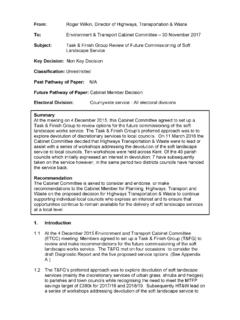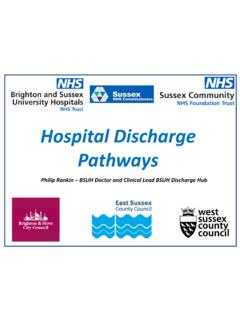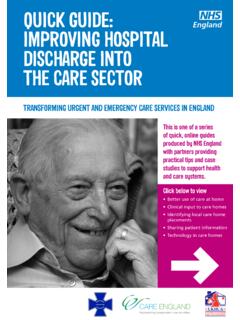Transcription of Kent and Medway Integrated Care System Development Plan
1 1 Kent and Medway Integrated Care System Development Plan 30 June 2021 Incorporating: Our Draft Operating Model and Next Steps 2 Kent and Medway ICS Development plan 30 June 2021 Contents 1 Introduction and context .. 3 2 The proposed Kent and Medway System 7 3 Stakeholder engagement - defining the end state .. 9 4 Design Principles .. 11 5 System Development Plan .. 14 6 The Draft Operating Model .. 14 The Kent and Medway ICS Governance Model .. 14 The ICS Partnership .. 20 The ICS NHS Body .. 22 7 The transition from CCG to ICS NHS Body .. 27 8 Communications and Engagement .. 29 9 Risks and the risk management approach .. 30 10 Conclusion and next steps .. 32 Appendices 1. Stakeholder engagement: Key Issues relating to the establishment of an ICS 2. The K&M System and ICS Body Transition and Development Plan 3.
2 Our draft ICS NHS Body functional model 4. ICS Development excerpt from our nine System priorities - Plans on a Page 5. Additional documents and products Development plan Glossary CCG Clinical Commissioning Group H&WBB Health and Well-Being Board ICP Integrated Care Partnership ICS Integrated Care System KM Kent and Medway NHSEI NHS England and Improvement OD Organisational Development PCN Primary Care Network PHM Population Health Management QI Quality Improvement SOF System Oversight Framework SQG System Quality Group 3 Kent and Medway ICS Development plan 30 June 2021 1 Introduction and context Our Vision: We will work together to make health and wellbeing better than any partner can do alone By doing this, we will: Give children the best start in life and work to make sure they are not disadvantaged by where they live or their background, and are free from fear or discrimination.
3 Help the most vulnerable and disadvantaged in society to improve their physical and mental health; with a focus on the social determinants of health and preventing people becoming ill in the first place. Help people to manage their own health and wellbeing and be proactive partners in their care so they can live happy, independent and fulfilling lives; adding years to life and life to years. Support people with multiple health conditions to be part of a team with health and care professionals working compassionately to improve their health and wellbeing. Ensure that when people need hospital services, most are available from people s nearest hospital; whilst providing centres of excellence for specialist care where that improves quality, safety and sustainability. Make Kent and Medway a great place for our colleagues to live, work and learn.
4 As we progress our plans to be a thriving Integrated Care System , our vision and ambition will drive everything we do. All System partners will work together to improve the quality of our services, the care people receive and the experience of our combined workforce. We will do this as part of our commitment to delivering the triple aim: better health for everyone better care for all efficient use of NHS resources. 4 Kent and Medway ICS Development plan 30 June 2021 The Kent and Medway System Development Plan and Operating Model map our programme of work over the next year towards achieving this ambition. This plan is not a stand-alone document and is aligned to the following: K&M System Priorities The Kent and Medway Operating Plan NHS Long Term Plan (2021) ICS Accreditation Submission The Kent and Medway CCG merger application To support our journey to becoming a thriving System , we have an agreed a set of principles which describe how we will work together including, making decisions as close to communities as possible, listening and acting on the views of our staff and developing our digital capabilities to provide one version of the truth.
5 Alongside existing challenges and health inequalities, we recognise the impact that the COVID-19 pandemic has had on our population and workforce. We are therefore currently focussing on priority areas that both support our individual organisations and provide System leadership in key areas where working together will get better results. This document outlines our proposals for the Development of the Kent and Medway Integrated Care System and in particular our plans relating to the ICS Operating Model and the transition to an ICSNHS Body in April 2022 (subject to parliamentary approval of the NHS Bill). The draft proposals outlined for the ICS Operating Model are founded first and foremost on the need to tackle health inequality and improve health and well-being across the whole of our population. The Operating Model, governance framework and architecture will be developed and refined based on this core principle, ensuring the way we go about our work will be inclusive, fair, consistent, transparent and efficient.
6 Our plans will continue to be refined over the summer and autumn months, building on the key national guidance, including the ICS Design Framework and model NHS Body Constitution. This is in the context that the accountability for delivering services within available resources remains with individual partner organisations of the ICS. Thus we need to align System and place responsibilities with the continued responsibilities of those organisations. The Kent and Medway context The Kent and Medway System has much to be proud of and the vast majority of our population receives good care and treatment. There are many services that provide high quality care day after day and will continue to do so. Indeed, since the establishment of CCGs in 2013 and the sustainability and transformation partnership in 2016 the NHS and social care in Kent and Medway have had a number of successes improving local services and improving patient outcomes.
7 Many of our providers within community, mental health and primary care services are now rated good or outstanding and we have seen sustained improvement in cancer pathways, the delivery of diagnostic and elective activity and, of course, the monumental effort of all of our staff pulling together during the COVID-19 pandemic, vaccination and recovery 5 Kent and Medway ICS Development plan 30 June 2021 programmes. This has already brought real benefits to the way we plan and deliver services at a System , place and neighbourhood level; and, we are working closer than we have ever done before. We recognise that whilst we have many achievements to be proud of, there are fundamental challenges that we have not yet been able to fully tackle and which have impacted negatively on individual patient experience, care and well-being.
8 Not least that we need to focus more on working together to support people so they don t get ill in the first place. Indicators of the challenges we must address together Only 2% of health and social care funding is spent on public health interventions to reduce the risk of avoidable disease and disability. Around 1,600 early deaths each year could have been avoided with the right early help and support. There are stark health inequalities across Kent and Medway . This is a particular issue for people who live in deprived areas and those with severe mental illness more likely to be affected. There is wide variation in life expectancy across Kent and Medway , for example life expectancy for women in Weald East ward is 35% higher than for men in Margate Central ward, a 25 year difference. Emergency admissions for COPD are higher in people from the most deprived 10% of our population compared to the least deprived 10% in almost all districts.
9 Emergency admission rates for stroke and TIA are 43% higher in the most deprived 10% of the population compared to the least deprived 10%. People in the most deprived 10% of the population have multiple morbidities equivalent to people 10 years older in the least deprived 10%. There are significant workforce issues across a range of health and care roles. Coastal areas in particular, have additional recruitment and retention challenges. Whilst workforce challenges are seen across the country, Kent and Medway is behind the national average. To respond to these challenges, and deliver our vision, we have identified nine improvement and Development priorities for 2021/22 which map directly back to our purpose and principles. These priorities formed a key part of our ICS accreditation process in February 2021.
10 Each of the priorities has an assigned System Senior Responsible Officer (SRO) and lead Director, working together to ensure progress, alignment and oversight. 6 Kent and Medway ICS Development plan 30 June 2021 The nine Kent and Medway System improvement and Development priorities We are committed to tackling health inequalities and improving health and well-being across the totality of our population. We will do this through: Greater collaboration and integration of our partners across various levels of the System : this will lead directly to better quality of care and better outcomes for local people. Whilst a primary design principle is one of subsidiarity and local autonomy, we also recognise that together, the System can be more than the sum of the parts and we will maximise the potential for improved health and well-being outcomes through Integrated delivery.









